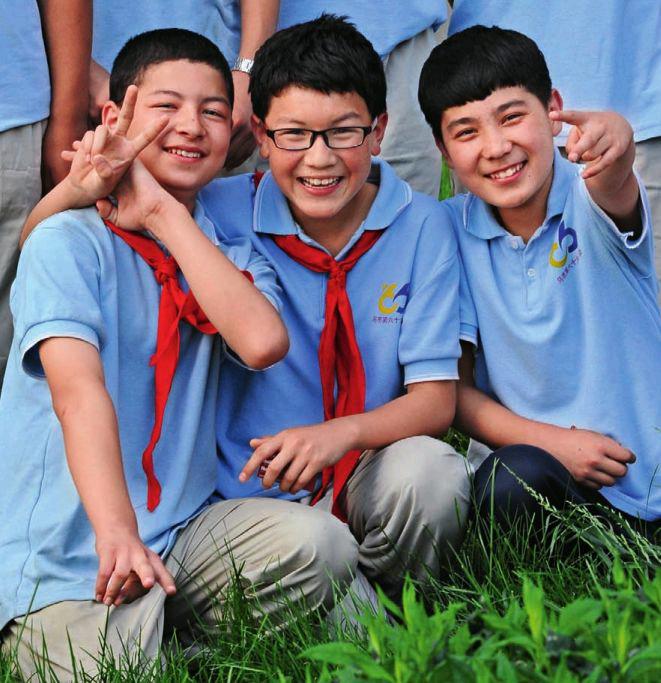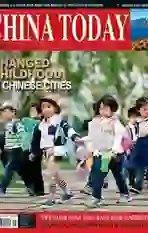Bilingually Mobile
2014-09-27ByXUHAO
By+XU+HAO
CHILDREN here are from various ethnic groups, notably Uygur, as well as Han. A main feature of the kindergartens early education is that although children are encouraged to speak Putonghua – standard Chinese– from a young age, care is taken not to let them forget their mother tongue,” Beibu Bay Radio (BBR) anchor Su Yan said on her micro-blog, which also showed pictures of the children at play.
Su Yan was talking about the Urumqi Red Flag Bilingual Kindergarten, established in 1949. The first public kindergarten to open in the city, Red Flag is located in a multi-cultural region where communities of several ethnic minorities, including Uygur, Kazak and Hui, live. There are two teachers and an asistant for each class, one of whom is Uygur.
Children at the kindergarten are trained to speak in both their mother tongue and Putonghua. In this way the Red Flag epitomizes bilingual education throughout Xinjiang Uygur Autonomous Region.
Bilingual Tots
“In the vast forest lives a smart little monkey...” four-year-old Adina Ekber repeated after her teacher in clear, toneperfect Putonghua. Her performance in a class attended by several other Uygur children elicited warm applause from visitors to the Red Flag.
“Learning Putonghua from Uygur teachers is easier for children of this ethnic minority group, and also helps create an environment where children are less shy about speaking Chinese to Han teachers,” Red Flag principal Zhang Xinmin said. “We hold many activities that enhance the childrens ability to communicate bilingually. One is a competition every semester, where the children tell stories and sing songs in two languages.”
The children learning Putonghua only and those attending bilingual class-es convene once a week to play games and study together. These exchanges encourage them to learn from one another, and help the children taking classes bilingually to express themselves more fluently in standard Chinese. The kindergarten also organizes various themed activities highlighting Xinjiangs distinct culture, such as “We All Belong to the Same Family and Love Each Other” and“Fruits of Xinjiang.” They encourage children to express their opinions and ideas on familiar topics.
“Conversation and communication promote linguistic abilities of ethnic minority children. We consequently encourage Han teachers to talk to them at every opportunity and so stimulate their desire to speak Putonghua,” Zhang Xinmin said.
“I can now speak Putonghua well enough to teach it to my grandpa at home. When I grow up I want to go to Shanghai, because my mom says its a beautiful city,” five-year-old Ayup told me.
Self-improvement
While doing interviews in Xinjiang, I found that more and more people from ethnic minorities want to become as proficient in Putonghua as they are in their mother tongue. In recent years, the bilingual ability of students in Xinjiang has substantially improved. But the problems of a dearth of bilingual teachers and textbooks remain.
One teacher said during an interview:“Many students are unable to understand lectures solely in Chinese, and those given in ethnic minority languages inhibit students potential to achieve good exam results. This means we must teach them Putonghua as well as factual professional knowledge. So we need first to clear the language barrier and then teach specific subjects in Putonghua.”
Limited teaching resources are still a main impediment to Xinjiangs development of bilingual education. Dealing with this shortage and helping teachers improve both their bilingual and teaching ability are hence main priorities.
“By 2020 we hope to have trained 165,500 bilingual teachers in Xinjiang,”said Dai Xiang, deputy director of the Bilingual Education Office of Xinjiang Uygur Autonomous Region. “Efforts to enroll and train more teachers over the past years have already paid off.”
The regional education administration launched in June of 2012 a program to raise the quality and ability of education staff. Measures included enrolling new students to train as supplementary school teachers, improving teachersteaching ability, and work-oriented training for students who want to be bilingual teachers. Courses cover preschool, elementary, and middle school education. Their focus is on improving teachers Putonghua communication skills and teaching ability.
Xinjiang also invested RMB 53 million in the comprehensive editing and revision of bilingual language and literature textbooks. Students started using the updated textbooks in September 2013.
Wings of a Dream
I met at Urumqis No. 66 Middle School 14-year-old Alim. He is in charge of the schools “Happy Sunday” program. It includes 10 or more regular activities, such as a folk dancing club, a basketball team, a film club, and a fun sports club. Alim, along with all students under the scheme that enrolls ethnic mi- nority children from Xinjiangs remote rural areas into selected schools in the regions bigger cities, so giving them access to quality education, is exempt from tuition fees. He also receives a government subsidy for living expenses.

Students participating in the scheme are mainly the children of farmers and herdsmen in less developed areas. Alim is from Yarkant County in Kashgar Prefecture in southwestern Xinjiang. Some of the young people there find work in Urumqi and others go to big cities like Beijing and Shanghai. Some even go abroad. But Alim has decided to return to his hometown when he finishes school to help with local development.“My dream is to enter Zhejiang University, and after graduation come back to Kashgar and be a policeman. Then I can protect the people. My parents are both farmers. If not for the money from the government, I would never have had the chance to leave Yarkant,” Alim said.
Guliweina is a 13-years-old girl from Toksun County in Turpan, 162 kilometers from Urumqi. Having started learning Putonghua at kindergarten, and English at third grade in elementary school, she is trilingual in Uygur, Chinese and English. “Children in my hometown are willing to learn Putonghua because they want to pass the entrance exam to middle schools in bigger cities. This gives them the chance to go to a good university and see more of China and beyond,”Guliweina said.
“The scale of bilingual education in Xinjiang has considerably expanded. More parents now realize that their children must clear the language barrier to improve their prospects,” Dai Xiang said. Bilingual education aims to cultivate students who understand Han culture as well as that of their own ethnic groups. This will provide Xinjiang residents with a broader view and a bigger development platform. Bilingual education can narrow the education gap between inland and remote border areas. It can also enable the people of Xinjiang to share the fruits of reform with those in other parts of the country.
